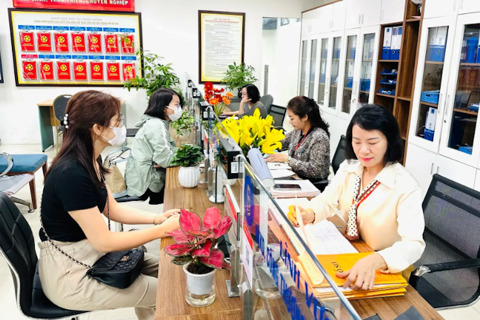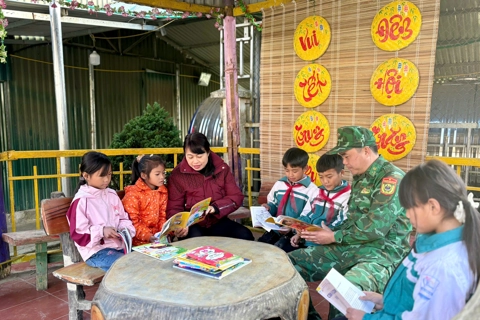Social Affairs
Hanoi to provide vocational training for 30,490 rural resident in 2016
Aug 18, 2016 / 10:01 PM
In 2016, the capital of Hanoi strives to provide the vocational training for 30,490 rural residents, increasing by nearly 142% against last year with the total cost of 69.815 billion VND.
Vice Chairman of Hanoi People's Committee Ngo Van Quy said at the conference on August 16 that the city considers vocational training for rural residents as the key task of its job creation, poverty reduction and new-rural area building.
Vice Chairman Quy required all departments, districts and towns across the locality make drastic measures to accomplish the city's target of poverty reduction and vocational training for rural workers this year.
The report of the municipal Department of Labour, Invalids and Social Affairs showed that more than 4,900 poor and near-poor households received preferential loans from the Vietnam Bank for Social Policy in the first half of this year.
The figure is expected to increase in the remaining months of 2016, according to the department.
As many as 386,782 beneficiaries of Government Programme 135, which aims to improve living conditions for rural residents, have been provided with health insurance at a total cost of 240 billion VND (10.8 million USD).
The municipal Department of Labour, Invalids and Social Affairs worked with the Vietnam Joint Stock Commercial Bank for Industry and Trade (Vietinbank)’s trade union to build houses in ethnic minority and mountainous regions at a total cost of 5 billion VND (225,000 USD).
As of August 14, more than 88 percent of underprivileged families in Hanoi capital had access to digital and cable television under the national scheme on digitising terrestrial TV by 2020.
The municipal Department of Labour, Invalids and Social Affairs has coordinated with Viettel group to provide 2,000 mobile phones to low-income households in ethnic minority and mountainous regions.
The city has paid electricity subsidies to 65,377 disadvantaged households.
Hanoi is home to over 65,300 needy households and 34,000 near-poor households, accounting for 3.64 percent and 1.89 percent of total households, respectively.
The city targets to reduce the rate of poverty to below 1.2 percent by 2020.
The Hanoi Department of Construction has submitted to the municipal People’s Committee for approval a project on accommodation for the needy in 2016 and the following years.
The capital is attempting to cut the rate of poverty by 1.3 percent, equivalent to 27,000 poor households, in 2016, with preferential policies.
In 2016, Hanoi strives to provide the vocational training for 30,490 rural residents, rising by nearly 142% against a year ago with the total cost of 69.815 billion VND. In the first six months of this year, the capital provided the vocational training for 5,110 rural labourers in 10 districts and 149 towns, reaching 17%.
The report of the municipal Department of Labour, Invalids and Social Affairs showed that more than 4,900 poor and near-poor households received preferential loans from the Vietnam Bank for Social Policy in the first half of this year.
The figure is expected to increase in the remaining months of 2016, according to the department.
As many as 386,782 beneficiaries of Government Programme 135, which aims to improve living conditions for rural residents, have been provided with health insurance at a total cost of 240 billion VND (10.8 million USD).

Illustrative image
|
As of August 14, more than 88 percent of underprivileged families in Hanoi capital had access to digital and cable television under the national scheme on digitising terrestrial TV by 2020.
The municipal Department of Labour, Invalids and Social Affairs has coordinated with Viettel group to provide 2,000 mobile phones to low-income households in ethnic minority and mountainous regions.
The city has paid electricity subsidies to 65,377 disadvantaged households.
Hanoi is home to over 65,300 needy households and 34,000 near-poor households, accounting for 3.64 percent and 1.89 percent of total households, respectively.
The city targets to reduce the rate of poverty to below 1.2 percent by 2020.
The Hanoi Department of Construction has submitted to the municipal People’s Committee for approval a project on accommodation for the needy in 2016 and the following years.
The capital is attempting to cut the rate of poverty by 1.3 percent, equivalent to 27,000 poor households, in 2016, with preferential policies.
In 2016, Hanoi strives to provide the vocational training for 30,490 rural residents, rising by nearly 142% against a year ago with the total cost of 69.815 billion VND. In the first six months of this year, the capital provided the vocational training for 5,110 rural labourers in 10 districts and 149 towns, reaching 17%.








